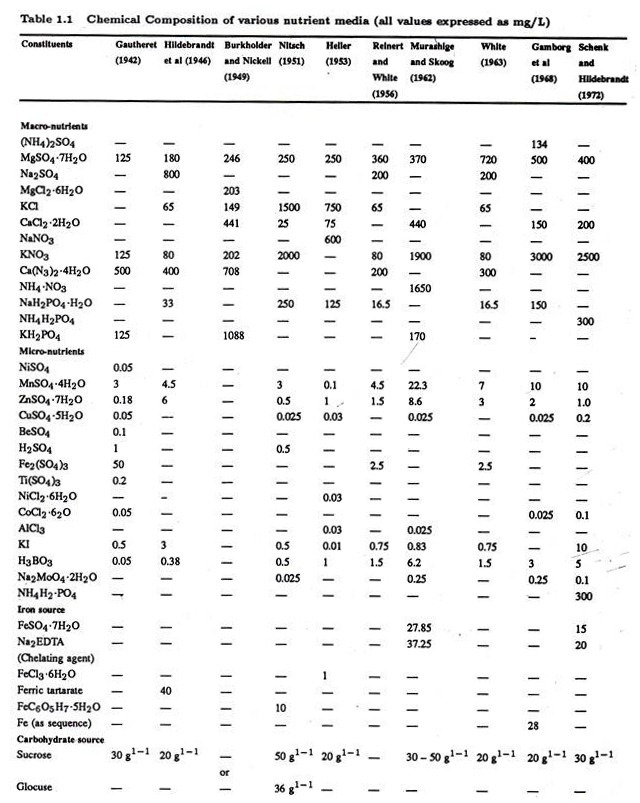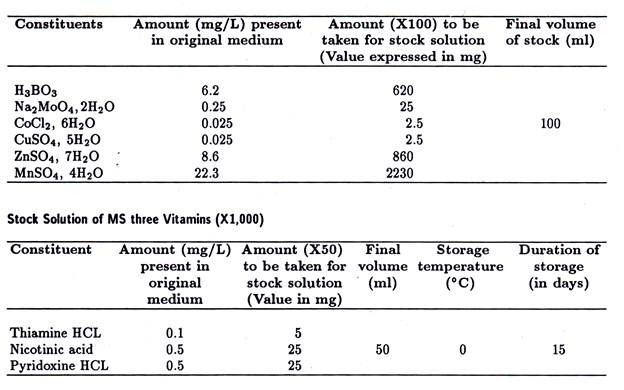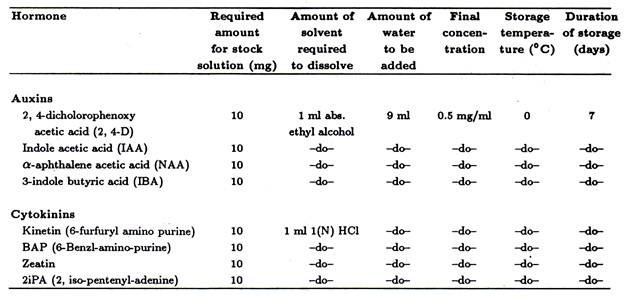Let us make in-depth study of the culture medium, basic composition of a general plant tissue culture medium and the preparation of stock solution.
Culture Medium:
Excised plant tissues and organs will only grow in vitro on a suitable artificially prepared nutrient medium which is known as culture medium.
From time to time, many workers (Murashige and Skoog, White, Gamborg, Nitsch and Nitsch, Schenk and Hildebrandt etc.) have proposed the composition of a nutrient medium for the growth of plant tissue (Table 1.1).
But no single medium is capable of maintaining optimum growth of all plant tissues. Consequently the most suitable medium for a particular tissue must be determined by trial and error. Proposed composition of a culture medium has often been modified to stimulate the growth of a particular plant material.
A culture medium is composed of inorganic salts, an iron source, vitamins, amino acids, growth substance (hormones) and a carbohydrate supply. Inorganic salts are supplied in two groups—as macro-salts or nutrient and as micro- salts or nutrients. The salts needed in higher amounts are called macro-salts. These include nitrogen, phosphorus, sulphur, magnesium, calcium, potassium.
The other essential inorganic salts needed in little amounts are called micronutrients (see Table 1.1). Nitrogen is mostly provided in two forms—as nitrates and as ammonium compounds. When nitrate is used alone, the pH of the medium drifts towards alkalinity, but adding ammonium compounds together with nitrate, checks the drift of pH.
In most media, iron may be chelated as ferric-sodium ethylene-amine tetra-acetate (Fe-EDTA). In this state, iron is gradually released into the culture medium as it is utilized by the living cells. Vitamins used in culture media are mesoinositol, nicotinic acid, pyridoxine, thiamine etc. Carbohydrate is supplied usually as sucrose.
The most commonly used amino acid is glycine. In addition, phytohormones (auxins and cytokinins) or their synthetic counterparts are required either singly or in combination to initiate and maintain cell division. The concentration and ratio of hormones may vary from plant to plant and should be standardized for a particular plant tissue. Gibberellic acid (GA3) is rarely used in medium.
Reports of the effect of GA3 in promoting cell growth in general are conflicting, although in some cases stimulation of cambial activity in shoot segments and cell division in cell suspension culture has been noted. The auxins that are commonly used in culture medium are IAA (indole-3-acetic acid), 2-4-D (2, 4-dichloro- phenoxyacetic acid), BTOA (2-benz-thizolyacetic acid), NAA (a-naphthalene acetic acid), IB A (3-indole butyric acid). The cytokinins are kinetin (6-furfurylaminopurine), 6-BAP (6, Benzylaminopurine), Zeatin, 2iPA (2, isopentenyladenine). The hormones are physiologically active in very small quantities.
The inorganic and organic chemicals used in the preparation of media should be analytical grades i.e. ‘AR’ (Analar or Analytical reagent) or GR (Guaranteed reagent). Some plant tissues grow in the presence of complex additives such as coconut milk, casein hydrolysate, yeast extract, water melon juice, malt extract, potato extract, ripe tomato extract, orange juice etc. Yeast extract is a good source of organic nitrogen and vitamins. Casein hydrolysate is obtained from milk by removing the cream and acidifying the skimmed milk which causes casein to precipitate without any decomposition.
It contains all the common amino acids. Potato extract, ripe tomato extract, orange juice and water melon juice contribute a number of essential nutrients and vitamins. Diphenylurea, a growth factor found in coconut milk, exhibits cytokinin-like responses. So, as a source of cytokinin, 10-15% v/v coconut milk is added to the medium.
On the basis of constituents, culture media are of two types:
(i) Chemically defined and
(ii) Chemically undefined.
Chemically defined medium is a medium in which the composition and the concentration of all constituents are known. It is mainly prepared from inorganic and organic chemicals. Chemically undefined medium is a medium in which the exact composition and the concentration of all constituents are not known due to addition of natural products, e.g. coconut milk. The concentration of the constituents of the natural products may vary and depends upon the physiological condition of and the environmental conditions to which a plant is growing.
A medium may be solid or semisolid or liquid. When 6-8% agar is dissolved in the liquid nutrient medium, it makes a solid medium. A partially solidified medium is known as semisolid medium where the amount of agar added is reduced. A medium without agar remains in liquid form and is known as liquid medium. Broadly speaking, solid and semisolid media are prepared for callus culture and liquid medium is used for cell suspension cultures. Actually, both types of media are used in different types of culture techniques.
Preparation of Stock Solution:
It is not possible to weigh and mix all the constituents just before the preparation of medium. It is time-consuming and a tedious job. Again if 100 ml or 200 ml medium is to be prepared, then it is very difficult to weigh some constituents that are used in very small quantity for one litre medium.
So it is convenient to prepare the concentrated stock solutions of macro- salts, micro-salts, vitamins, amino acids, hormones etc. All stock solutions should be stored in a refrigerator and should be checked visually for contamination with microorganisms or precipitation of ingredients.
Stock solution of vitamins, amino acids and hormones should not be stored for indefinite period and should be kept in a deep freezer chamber. The widely used culture medium was formulated by Murashige and Skoog (commonly called MS medium), so the procedure for the preparation of stock solution of MS medium (1962) is given below:
Particularly macro-salts should be made at ten/twenty times of (X10 or X20) their final concentration in the medium while micro-nutrients can be prepared at thousand time (X 1,000) of their final strength. While making the stock solutions, it is advisable to dissolve each constituent completely before adding another otherwise precipitation of salts may occur.
Stock Solution of Macro-Salts (X20):
To make 1,000 ml of this stock solution, dissolve the salts one after another in 800 ml of double distilled water (DDH2O) and then make up the volume. The solution is filtered and can be stored in refrigerator (10-16°C) for a long period until the solution is totally used.
Stock Solution of KI (X1,000):
Dissolve 83 mg of KI (0.83 mg/L present in original medium) in 100 ml of DDH2O. Store in refrigerator (10-16°).
Stock Solution of Iron (X200):
Dissolve at first 745 mg of Na2EDTA (37.25 mg/L in original) in 75 ml boiling double distilled water, then add gradually 557 mg of FeSOO4 7H2O (27.85 mg/L in original). Keep on a magnetic stirrer for at least 1hr in hot condition until the colour of the solution changes to golden yellow. Finally make the volume to 100 ml and store in refrigerator (5°C). This solution specifically must be kept in an amber coloured bottle.
To make 100 ml of this stock solution, dissolve the salts sequentially as shown above. One by One in 80 ml of DDH2O. Make up the final volume. Filter and store the solution at approximately 5°C in a refrigerator for long periods until the solution is totally used.
Stock Solution of Meso-Inositol (X500):
Dissolve 1gm meso-inositol (100 mg/L in original) in 20 ml DDH2O. Store at 0°C for 15 days.
Stock Solution of Glycine (X1, 000):
Dissolve 40 mg glycine in 20 ml of DDH2O. Store at 0°C for 15 days.
Stock Solution of Hormones:
These stock solutions are not specific for MS medium. So stock solutions of hormones are general and can be used in any medium at any combinations and concentrations. Auxins and cytokinins are not directly dissolved in water. So they are at first made soluble in water miscible solvents and then water is added to get the final volume. Auxins and cytokinins are available either in powder or’ in crystal forms. Preparation of stock solutions of commonly used auxins and cytokinins are given above.




